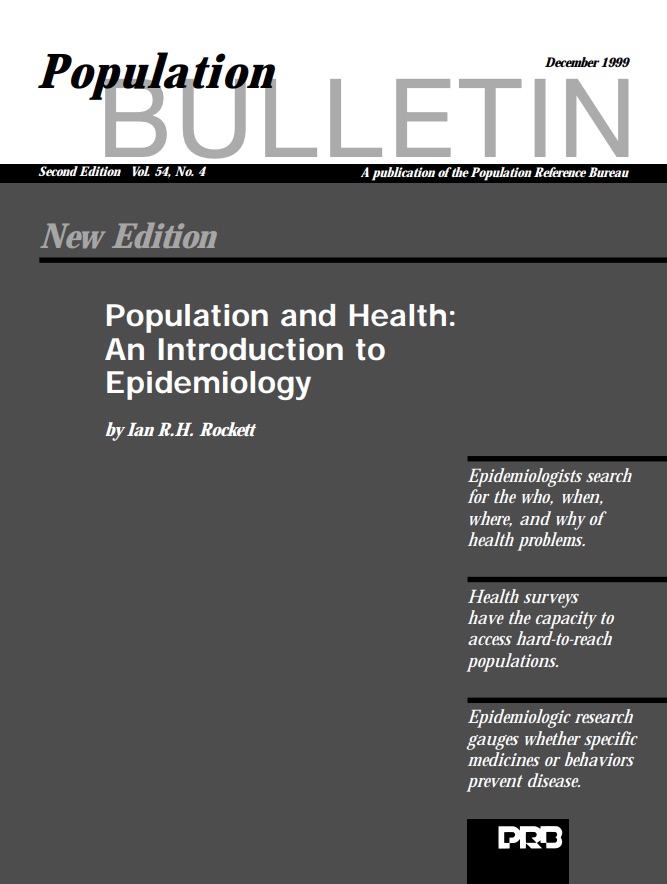
Population and Health: An Introduction to Epidemiology
Product: Population Bulletin vol. 54, no. 4
Author: PRB
Date: December 1, 1999
(December 1999) Most people are concerned about their health. When they are well, they wonder how to remain that way. Will regular exercise decrease their risk of cardiovascular disease later in life? Will betacarotene or vitamin C reduce their risk of getting cancer? Does living near overhead power lines increase that risk? When they, their families, or friends are ill, they wonder which treatments would be best. Is chemotherapy more effective than surgery and radiation in treating cancer? Is angioplasty more appropriate than heart bypass surgery for treating blocked arteries?
Television, newspapers, and magazines fuel this widespread curiosity about the mysterious world of health risks and hazards. How dangerous is radiation exposure? Which populations face the greatest risks? What are the risks of injury in an automobile crash when driving intoxicated versus driving sober, and how are those risks modified in cars with airbags?
All too often, discussions of these and similar questions are characterized more by ignorance or fear than by scientific knowledge. But, the quality of these discussions is being enhanced as scientific research becomes more accessible to the public. The science of epidemiology is a major contributor to this growing body of knowledge about how to prevent and treat disease and injury.
What is epidemiology? It may be formally defined as the “study of the distribution and determinants of health-related states or events in specified populations, and the application of this study to control of health problems.” In other words, epidemiology is the study of our collective health. Epidemiology offers insight into why disease and injury afflict some people more than others, and why they occur more frequently in some locations and times than in others— knowledge necessary for finding the most effective ways to prevent and treat health problems.
The term “epidemiology” springs directly from “epidemic,” which originally referred to communicable disease outbreaks in humans. Epidemic is derived from the Greek roots epi (upon) and demos (people). The third component of epidemiology, the Greek root logos, means study. Demos and another Greek root, graphein (to write, draw), combine to form the term demography, a kindred population-based science. Not only do epidemiology and demography share a linguistic heritage and other historical origins, they also overlap considerably in their data sources and research domains.
Epidemiology has a descriptive dimension that involves the identification and documentation of patterns, trends, and differentials in disease, injury, and other health-related phenomena. This science also has an analytic dimension, in which the etiology, or causes, of these phenomena are investigated. Epidemiology also helps investigate how well specific therapies or other health interventions prevent or control health problems.
Because health is multifaceted, epidemiology is interdisciplinary. Epidemiology is substantively and traditionally connected to the health and biomedical sciences such as biology, chemistry, anatomy, physiology, and pathology; and it is closely tied to statistics or, more precisely, biostatistics. In the search for solutions to health problems, however, the interdisciplinary net of epidemiology is often cast beyond these traditional boundaries to incorporate still other disciplines, such as social and behavioral sciences, communications, engineering, law, cartography, and computer science. The complexity of health problems has even spawned specialties within the discipline, including clinical epidemiology, genetic epidemiology, nutritional epidemiology, reproductive epidemiology, injury epidemiology, environmental epidemiology, social epidemiology, and veterinary epidemiology.
Many epidemiologists have earned degrees in medicine or some other specialty as well as graduate degrees or certificates in epidemiology. They work in diverse occupational settings— including international, national, and local health agencies and universities; teaching hospitals; and private corporations. Epidemiologists may be found, for example, in the chemical, pharmaceutical, electronics, energy, automotive manufacturing, and air travel industries.
Epidemiology provides a unique way of viewing and investigating disease and injury. The keys to understanding health, injury, and disease are embedded in the language and methods of epidemiology. Many of the basic epidemiologic concepts are familiar to most people, although only superficially understood. They reside in such everyday terms as exposure, risk factor, epidemic, and bias. This Population Bulletin explains the terms, methods, and materials scientists use to study the health of populations, as well as the historical underpinnings of the modern-day science of epidemiology.
Ian R.H. Rockett is professor of epidemiology and director of the Bureau of Evaluation, Research, and Service at the University of Tennessee, Knoxville. He is affiliated with the University’s Community Health Research Group and Department of Exercise Science and Sport Management.

 ">
">